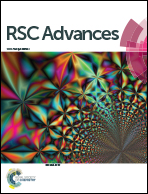Stretchable self-healing hydrogels capable of heavy metal ion scavenging†
Abstract
Self-healing hydrogels were prepared by simply mixing phytic acid (PA) and chitosan (CS) in water. Determined by scanning electron microscopy (SEM), the hydrogels were found to be a three-dimensional (3D) porous network structure. The formation of the network structure was considered to be mainly driven by electrostatic interactions and hydrogen bonding, cooperating with the subtle balance of multiple noncovalent interactions. The rheological data indicated that the hydrogels presented excellent mechanical properties with an elastic modulus of 20 000 Pa and a yield stress exceeding 7000 Pa. The dynamic dissociation and recombination of hydrogen bonding and electrostatic interaction in fractured regions of the gels initiated the self-healable property of PA/CS hydrogels. Since PA had high coordination ability to metal ions, PA/CS hydrogels were shown to exhibit excellent capability for capturing heavy metal ions, for example, Pb2+ and Cd2+. The PA/CS hydrogels provided a simple, green, and high efficiency strategic approach to scavenging heavy-metal ions from industrial sewage.



 Please wait while we load your content...
Please wait while we load your content...